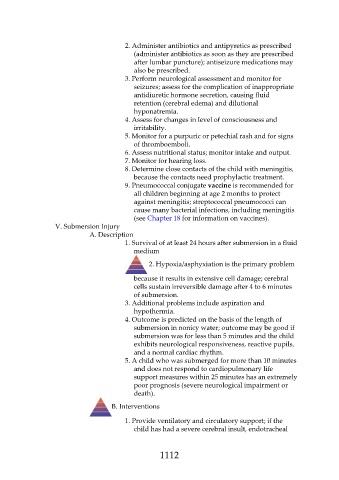Page 1112 - Saunders Comprehensive Review For NCLEX-RN
P. 1112
2. Administer antibiotics and antipyretics as prescribed
(administer antibiotics as soon as they are prescribed
after lumbar puncture); antiseizure medications may
also be prescribed.
3. Perform neurological assessment and monitor for
seizures; assess for the complication of inappropriate
antidiuretic hormone secretion, causing fluid
retention (cerebral edema) and dilutional
hyponatremia.
4. Assess for changes in level of consciousness and
irritability.
5. Monitor for a purpuric or petechial rash and for signs
of thromboemboli.
6. Assess nutritional status; monitor intake and output.
7. Monitor for hearing loss.
8. Determine close contacts of the child with meningitis,
because the contacts need prophylactic treatment.
9. Pneumococcal conjugate vaccine is recommended for
all children beginning at age 2 months to protect
against meningitis; streptococcal pneumococci can
cause many bacterial infections, including meningitis
(see Chapter 18 for information on vaccines).
V. Submersion Injury
A. Description
1. Survival of at least 24 hours after submersion in a fluid
medium
2. Hypoxia/asphyxiation is the primary problem
because it results in extensive cell damage; cerebral
cells sustain irreversible damage after 4 to 6 minutes
of submersion.
3. Additional problems include aspiration and
hypothermia.
4. Outcome is predicted on the basis of the length of
submersion in nonicy water; outcome may be good if
submersion was for less than 5 minutes and the child
exhibits neurological responsiveness, reactive pupils,
and a normal cardiac rhythm.
5. A child who was submerged for more than 10 minutes
and does not respond to cardiopulmonary life
support measures within 25 minutes has an extremely
poor prognosis (severe neurological impairment or
death).
B. Interventions
1. Provide ventilatory and circulatory support; if the
child has had a severe cerebral insult, endotracheal
1112

